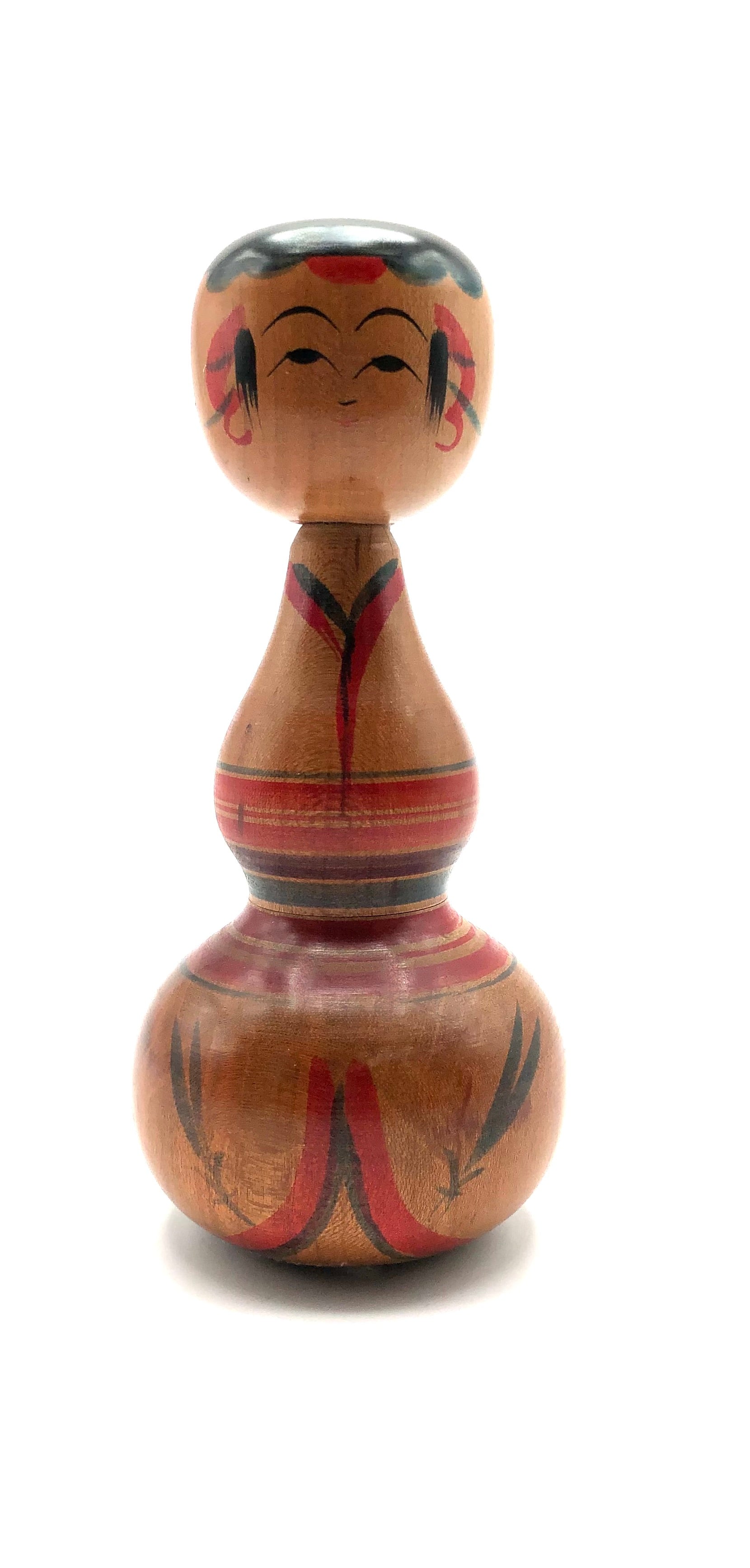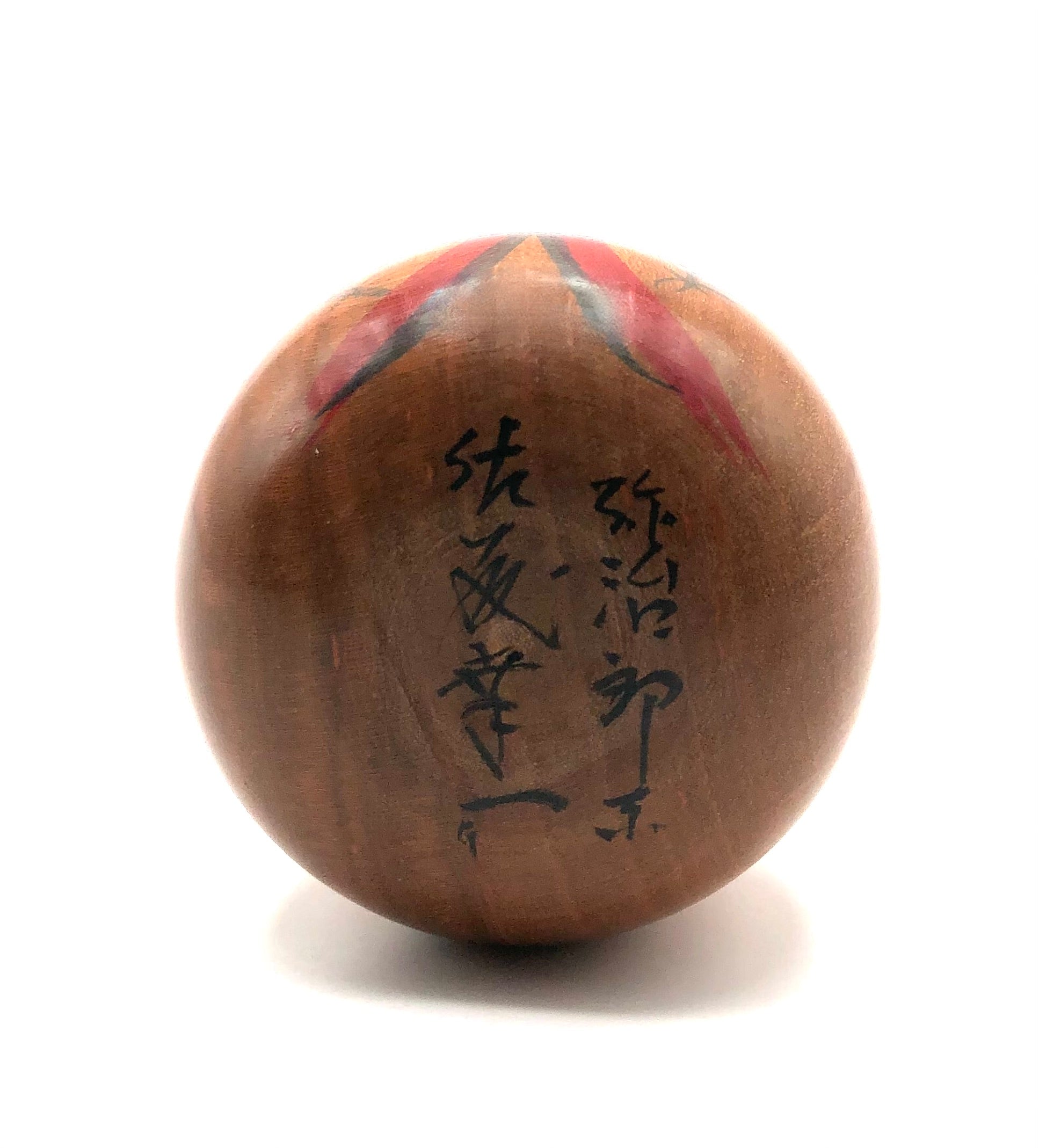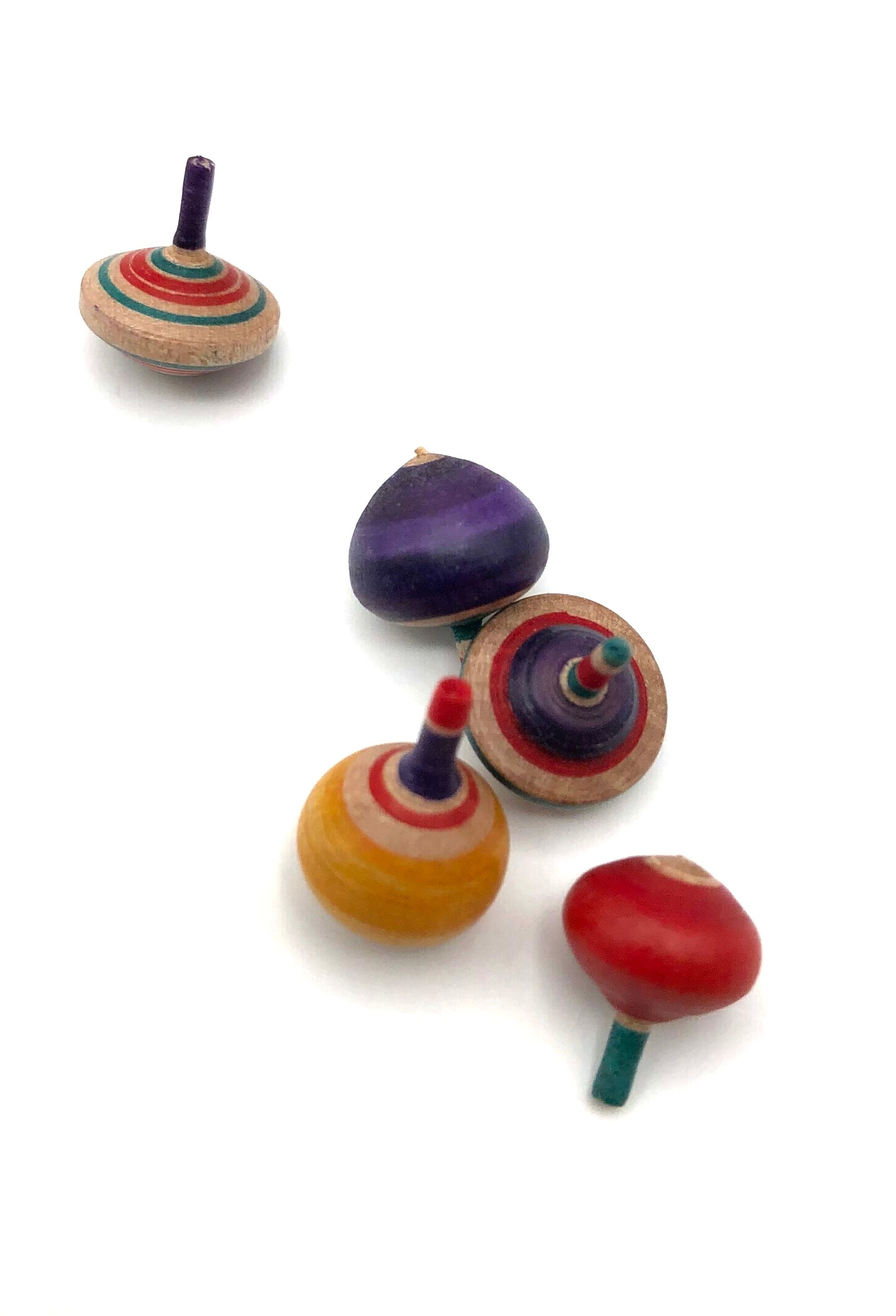







Vintage Japanese RARE Yajirou Ejiko Container with Miniature Spinning Tops/Daruma | Koma by Sato Koichi
Dimensions: 5-1/2” h x 2-3/8” dia.
The Ejiko’s origin is derived from a folk toy that is called an Izume.ko Doll, (Izume.Ko means “Isume baby”), which dates from the early 1910s, and which comes from Tsuruoka, of the Yamagata prefecture. This toy is made of one piece of Cherry, (Sakura), wood with five (5) miniature spinning tops and three (3) Daruma inside. Out of the earlier prototypes arose the Ejiko doll, which had its beginnings in the 1950s.
Firstly, the body is a very delicate undulating form created by an expert craftsman on a lathe. The head and bodice, (upper part of the Kimono), act as the top to the container and show a beautiful slender neck that attaches the head to the body. It then transits into the lower portions of the kimono using the Yajirou-Kei figure styling. This piece, being a container, is hollowed out with a beautifully formed lip, which joins at the waist by the simulated obi. This portion as the cover, or lid, is referred to as the Obunko. The body contains five (5) multi-colored miniature spinning tops, (Koma).
The government, during the Edo Period, issued a decree encouraging a modest and frugal lifestyle, which resulted in large dolls and toys being banned as luxuries. Thus, the people of Edo, (modern-day Tokyo) devised clever ways to create miniatures that were scaled down in size and were just as fun as full-size dolls and toys, and the culture of miniatures was born. New forms of miniatures still appear alongside the traditional ones being offered and continue to delight collectors all around the world. The Five (5) miniature tops and three (3) miniature Daruma were specifically made by the artist for this container, show fine details and shimmering colors and symbolize a respected Japanese tradition because it takes more refined skills to produce than life-size pieces.
The head is painted with a beret-like feature, or a bun, and has a red spot in the center, and hair on the sides. Side hair fringes with double eyelids and a cat-shaped nose complete the piece. The body of the container has Rokoru moyo horizontal strips in red, purple, and green reeds running on the lower portion. The Ejiko is finished with a type of natural candle wax,(Rosoku no ro). The Sato Koichi (佐藤幸一) was born in 1936, as the third son of confectioner Yotaro Sato in Shiroishi Miyagi Prefecture. In 1957, he learned woodworking from Heizaburo Hamazu and continued to work for Heizaburo through 1977 until be became independent in Shiroishi. The piece is signed and titled by the artist on the bottom of the container.
Condition: Superb, outstanding, excellent, impressive, and beautiful. It is void of chips, cracks, breaks, missing pieces, or restoration, and retains its original details and finish. With a wonderful presence, it was protected and treasured by the previous owner who purchased the piece from the craftsman. This artifact meets all the standards of the collectible Vintage Kokeshi Ejiko, and without question, is a unique treasure for the Japanese Kokeshi and toy collector.

Japanese Traditional Kokeshi
Yajirou-Kei (Family)
Prefecture: Miyagi
Origin:
This strain of Kokeshi is said to have been an offshoot of the Tougatta strain and is far less refined. That eventually developed into a unique style that remains today. The creators of these dolls hail from the small farming village of Yajirou-machi near Kamasaki Onsen, in Miyagi Prefecture, once a farming village between two tall mountains. The Kiji-shi (woodworkers) divided their time between farming and woodcraft. Those who made kokeshi in their spare time sent their wives to the nearby Kamasaki Onsen to sell their work to tourist shops and onsens.
Collector's note – characteristics/painting style:
The majority of this style has distinct waists, or (kubire), where the body tapers inward, with a wider, flared base similar to a kimono, thus making them very stable. The upper body usually has a hand-painted collar with horizontal stripes encircling the body, as in the Rokoru-moyo style, and vertical stripes running below the waist to the base of the doll. However, Yajirou dolls can also be found with a series of chrysanthemum petals running down the front of the body, or a branch of plum blossoms, as the only decoration. Yajirou dolls are some of the most brightly painted of the traditional family group. Utilizing a veritable rainbow of colours, from the usual red and black to green, yellow, and even blue and purple, they are available in probably the widest range of shapes. Some also have a painted beret-like feature or a bun on their heads, similarly painted with a red center spot. Less common are Yajirou who have conical hats known as Suge-Gasa. Typically seen is one lid or double eyelids and a cat or pick-shaped nose. Yajirou kokeshi have been made from cherry wood, camellia, and maple, but the preferred wood is white dogwood, (Mizuki). And finally, both Yajirou and Tougutta dolls are sometimes created with loose rings circling the waists. Carved from the same wood as the body, which is a very meticulous method! This treatment is referred to as 'Yamiyo' style kokeshi.

Leading, Craftsmen:
Niiyama, Keimi, 1925, (Shirabu, Yamagata) - Master Niiyama, Keimi. No additional published information
Niiyama, Fukutaro, 1898-1965 - No additional published information
Niiyama Fukuo, 1922, (Yajiro Shironishi, Miyagi) - Master: Niiyama, Fukutaro. No additional published information
Niiyama, Hisaharu, 1942-2008 - No additional published information
Niiyama, Sanai (Master) - No additional published information
Oizumi, Kiyoni - No additional published information
Saito Masao, 1932, (Shiroishi, Miyagi) - Master: Sato, Tsugio. No additional published information
Sato Tatsuo, 1928-2009, (Yajiro Shiroishi , Miyagi) - Master: Sato, Imasaburo. No additional published information
Sato Yoshiaki, 1936, (Shiroishi Miyagi) - Master: Sato, Tatsuo. No additional published information
Sato, Koichi, 1936, (Shiroishi, Miyagi) - Master:Hamatsu, Heisaburo. No additional published information
Explore & Learn More about Yajirou-Kei (Family)